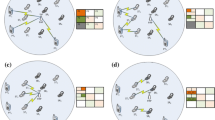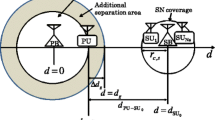Abstract
The fifth generation (5G) wireless networks are expected to achieve 1000 times higher capacity compared to the fourth generation (4G) wireless networks. This implies that maximizing the spectrum efficiency will be one of the key issues to 5G systems. In this paper we consider the problem of detecting and leasing the joint space and spectrum opportunities by a number of secondary network operators (SNOs) in a cognitive network. With the exploitation of an antenna array equipped at each SNO, the whole space in the view of the array can be sliced by multiple partially overlapped beams for each narrowband channel. We derive the energy detection probability of the primary users (PUs) at a given beam for each narrowband channel and the probabilities of that the PUs are located respectively at each neighboring beam under the condition of the PUs located at the given beam and the given narrowband channel. To maximize the spectrum utility, we propose to model the spectrum leasing market of the cognitive network for the obtained opportunities in the framework of the differential games, such that the spectrum price and demand are controlled by a dynamic system. We then derive the open-loop equilibria of the game. Simulation results confirm the efficacy of the proposed methods.










Similar content being viewed by others
References
Chen, S., & Zhao, J. (2014). The requirements, challenges, and technologies for 5G of terrestrial mobile telecommunication. IEEE Communications Magazine, 52(5), 36–43.
Li, Q., Niu, H., Papathanassiou, A.T., & Wu, G. (2014). 5G network capacity: key elements and technologies. IEEE Vehicular Technology Magazine, 9(1), 71–78.
Hu, R.Q., & Qian, Y. (2014). An energy efficient and spectrum efficient wireless heterogeneous network framework for 5G systems. IEEE Communications Magazine, 52(5), 94–101.
Haykin, S. (2005). Cognitive radio: brain-empowered wireless communications. IEEE Journal on Selected Areas in Communications, 23(2), 201–220.
Report of the spectrum efficiency group (2002). FCC Spectrum Policy Task Force Report.
Wang, B., & Liu, K.J.R. (2011). Advances in cognitive radio networks: a survey. IEEE Journal of Selected Topics in Signal Processing, 5(1), 5–23.
Yucek, T., & Arslan, H. (2009). A survey of spectrum sensing algorithms for cognitive radio applications. IEEE Communications Surveys Tutorials, 11(1), 116–130.
Zhao, Q., & Sadler, B. (2007). A survey of dynamic spectrum access: signal processing, networking, and regulatory policy. IEEE Signal Processing Magazine, 24(3), 78–89.
Zhu, K., Niyato, D., Wang, P., & et al. (2012). Dynamic spectrum leasing and service selection in spectrum secondary market of cognitive radio networks. IEEE Transactions on Wireless Communications, 11(3), 1136–1145.
Zhao, Q., & Liu, K. (2008). Detecting, tracking, and exploiting spectrum opportunities in unslotted primary systems. IEEE radio and wireless symposium (pp. 491–494).
Quan, Z, Cui, S., Sayed, A.H., & et al. (2009). Optimal multiband joint detection for spectrum sensing in cognitive radio networks. IEEE Transactions on Signal Processing, 57(3), 1128–1140.
Taherpour, A, Nasiri-Kenari, M., & Gazor, S. (2010). Multiple antenna spectrum sensing in cognitive radios. IEEE Transactions on Wireless Communications, 9(2), 814–823.
Tsakalaki, E.P., Wilcox, D., De Carvalho, E., & et al. (2012). Spectrum sensing using single-radio switched-beam antenna systems. IEEE 7th international ICST conference on cognitive radio oriented wireless networks and communications (pp. 118–123).
Wilcox, D., Tsakalaki, E., Kortun, A., & et al. (2013). On spatial domain cognitive radio using single-radio parasitic antenna arrays. IEEE Journal on Selected Areas in Communications, 31(3), 571–580.
Xu, Z., & et al. (2009). Spectrum sense utilizing multi-antenna beams scanning in cognitive radio networks. IEEE communications and information technology (pp. 1369–1374).
Osborne, M.J., & Rubinstein, A. (1994). A course in game theory. Cambridge: MIT Press.
Cellini, R, & Lambertini, L. (2007). A differential oligopoly game with differentiated goods and sticky prices. European Journal of Operational Research, 176(2), 1131–1144.
Niyato, D., & Hossain, E. (2007). A game-theoretic approach to competitive spectrum sharing in cognitive radio networks. IEEE wireless communication and networking conference (pp. 16–20).
Simeone, O., Stanojev, I., Savazzi, S., Bar-Ness, Y., Spagnolini, U., & Pickholtz, R. (2008). Spectrum leasing to cooperating secondary ad hoc networks. IEEE Journal on Selected Areas in Communications, 26(1), 203–213.
Niyato, D., & Hossain, E. (2007). Optimal price competition for spectrum sharing in cognitive radio: a dynamic game-theoretic approach. IEEE global telecommunications conference (pp. 4625–4629).
Niyato, D., & Hossain, E. (2008). Market-equilibrium, competitive, and cooperative pricing for spectrum sharing in cognitive radio networks: analysis and comparison. IEEE Transactions on Wireless Communications, 7 (11), 4273–4283.
Niyato, D., & Hossain, E. (2008). Competitive pricing for spectrum sharing in cognitive radio networks: dynamic game, inefficiency of Nash equilibrium, and collusion. IEEE Journal on Selected areas in Communications, 26(1).
Lin, P., Jia, J., Zhang, Q., & Hamdi, M. (2011). Dynamic spectrum sharing with multiple primary and secondary users. IEEE Transaction on Vehicular Technology, 60(4).
Duan, L., Huang, J., & Shou, B. (2010). Cognitive mobile virtual network operator: investment and pricing with supply uncertainty. IEEE international conference on computer communications (pp. 1–9).
Jia, J., & Zhang, Q. (2008). Competitions and dynamics of duopoly wireless service providers in dynamic spectrum market. Proceeding ACM MobiHoc (pp. 313–322).
Zhu, K., Niyato, D., Wang, P., & Han, Z. (2012). Dynamic spectrum leasing and service selection in spectrum secondary market of cognitive radio networks. IEEE Transactions on Wireless Communications, 11(3), 1136–1145.
Hao, D., Iwasaki, A., & Yokoo, M. (2012). A differential game theoretic model for real-time spectrum pricing in cognitive radio networks. IEEE 37th conference on local computer networks (pp. 236–239).
Rade, L., & Westergren, B. (1990). Beta mathematics handbook, Studentlitteratur, 2nd edn.
Dragone, D., Lambertini, L., Leitmann, G., & Palestini, A. (2009). Hamiltonian potential functions for differential games. Proceedings of IFAC CAO, vol. 9.
Wang, W., & Liu, X. (2005). List-coloring based channel allocation for open-spectrum wireless networks. Vehicular Technology Conference.
Erdos, P., Rubin, A.L., & Taylor, H. (1979). Choosability in graphs. In Proceedings of the west coast conference on combinatorics, graph theory and computing, congres. Num. (pp. 125–157).
Billionnet, A. (2003). Using integer programming to solve the train-platforming problem. Transportation science (pp. 213–222).
Aardal, K., van Hoesel, S., Koster, A., Mannino, C., & Sassano, A. (2007). Models and solution techniques for frequency assignment problems. Annals of Operations Research, 153, 79–129.
Garg, N., Papatriantafilou, M., & Tsigas, P. (2002). Distributed long-lived list colouring: how to dynamically allocate frequencies in cellular networks. Wireless Networks, 8(1), 49–60.
Bertsekas, D.P. (2012). Dynamic programming and optimal control. Athena Scientific.
Acknowledgments
This work is supported by National Natural Science Foundation of China with the grant no. 10990012 and 61172139.
Author information
Authors and Affiliations
Corresponding author
Rights and permissions
About this article
Cite this article
Li, G., Shang, Z. & Yang, K. Detection and Leasing of Joint Space and Spectrum Opportunities by Multiple Secondary Network Operators in Cognitive Radio Systems. J Sign Process Syst 83, 293–308 (2016). https://doi.org/10.1007/s11265-015-1085-2
Received:
Revised:
Accepted:
Published:
Issue Date:
DOI: https://doi.org/10.1007/s11265-015-1085-2




